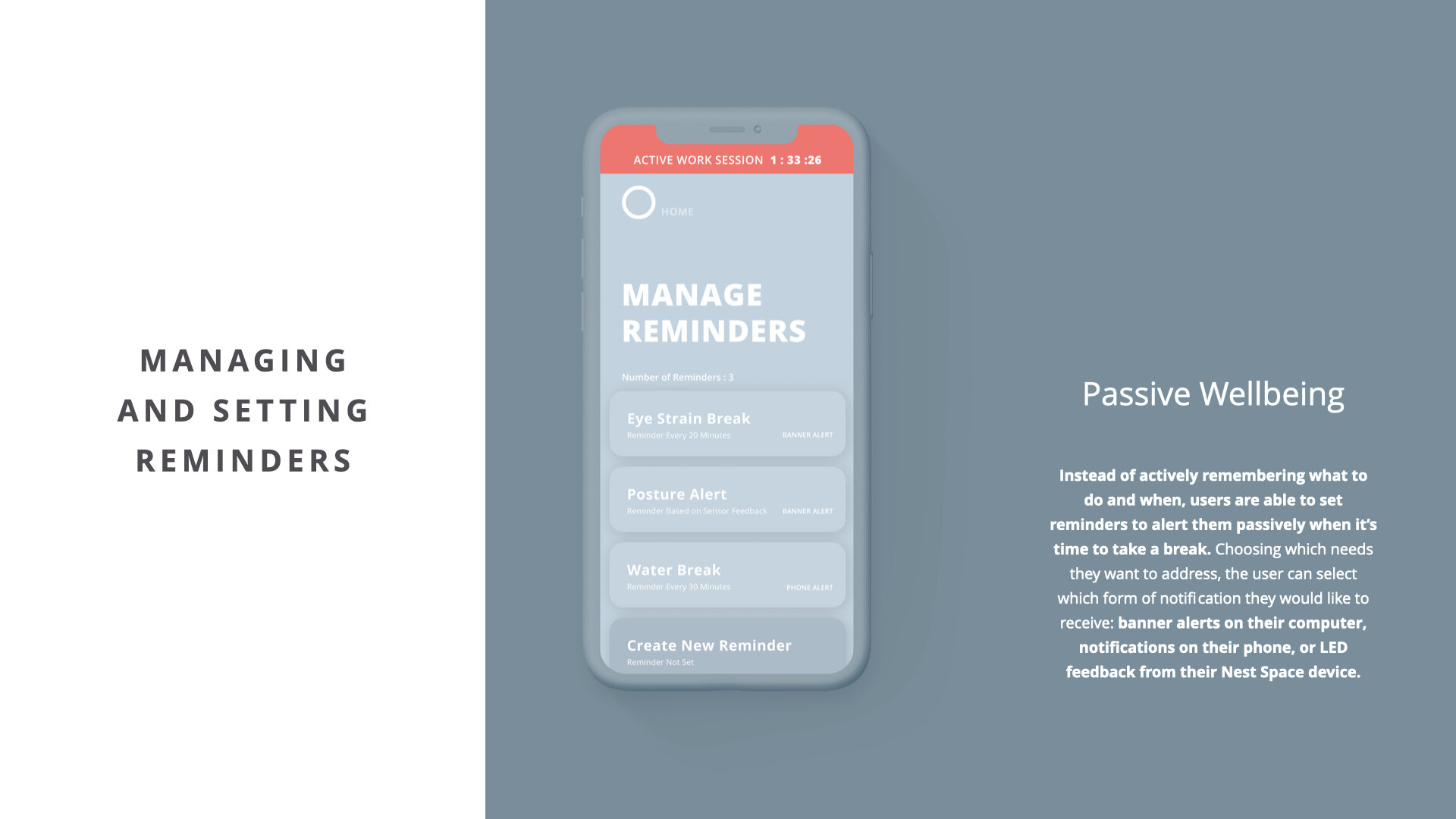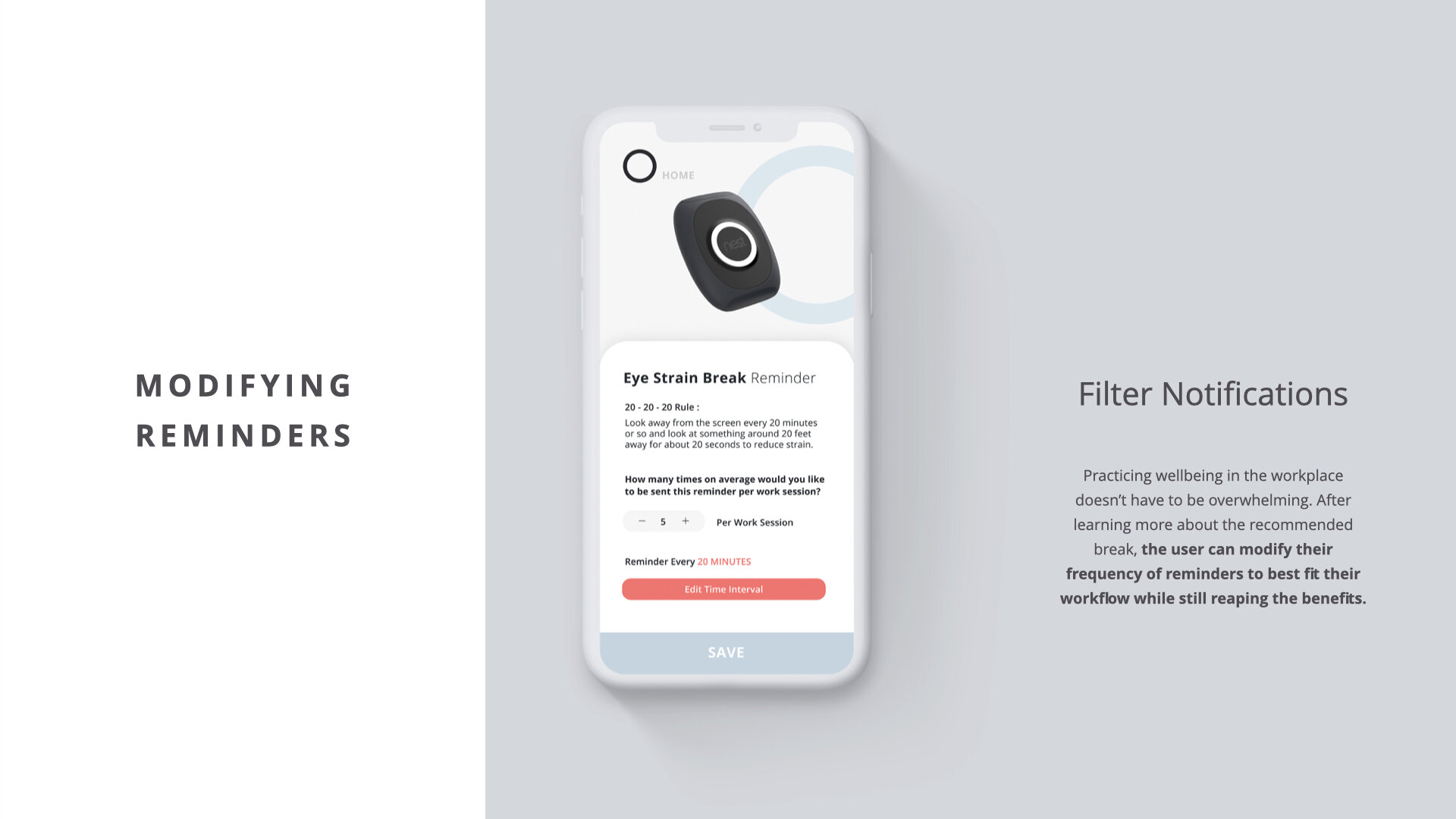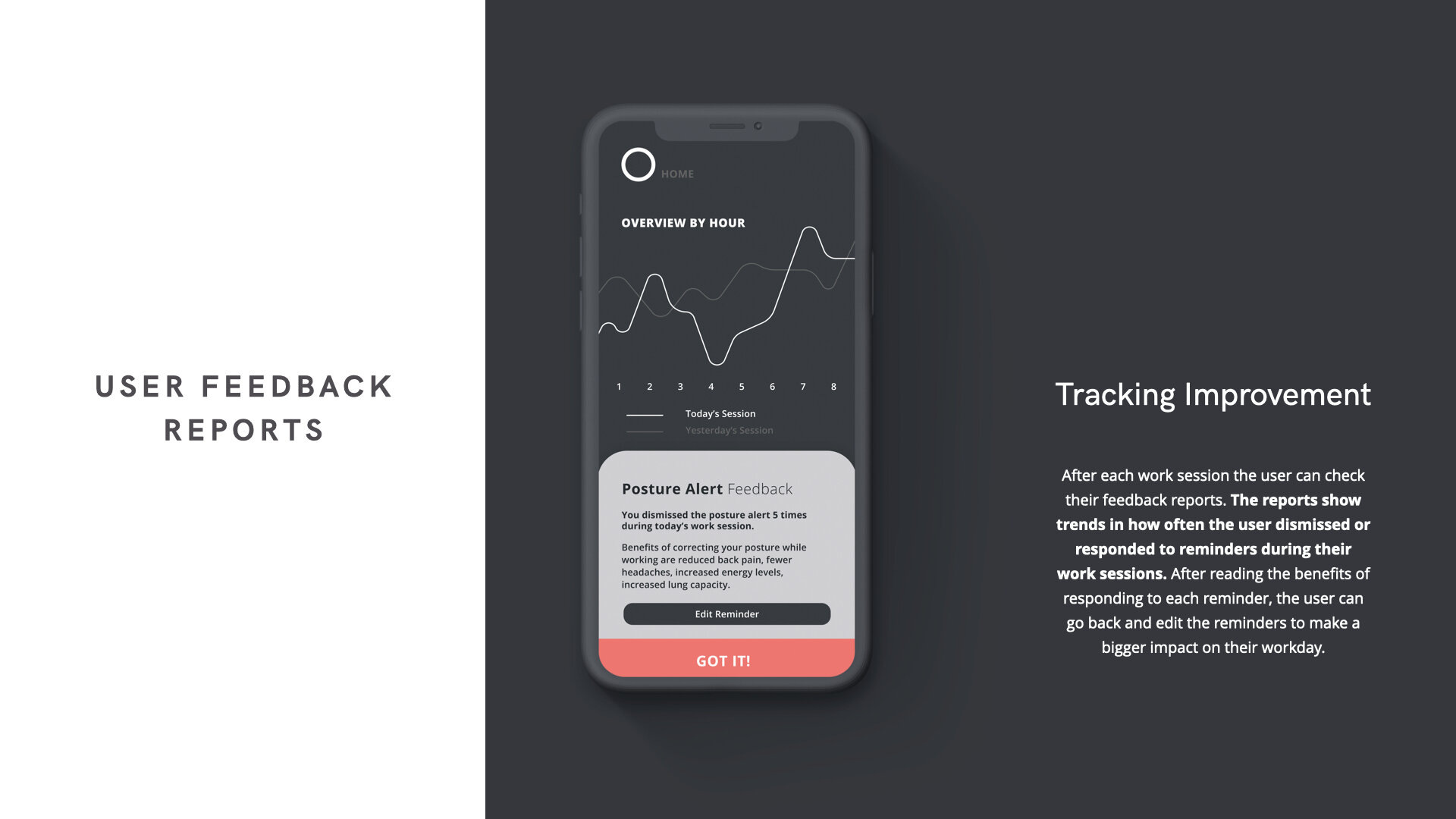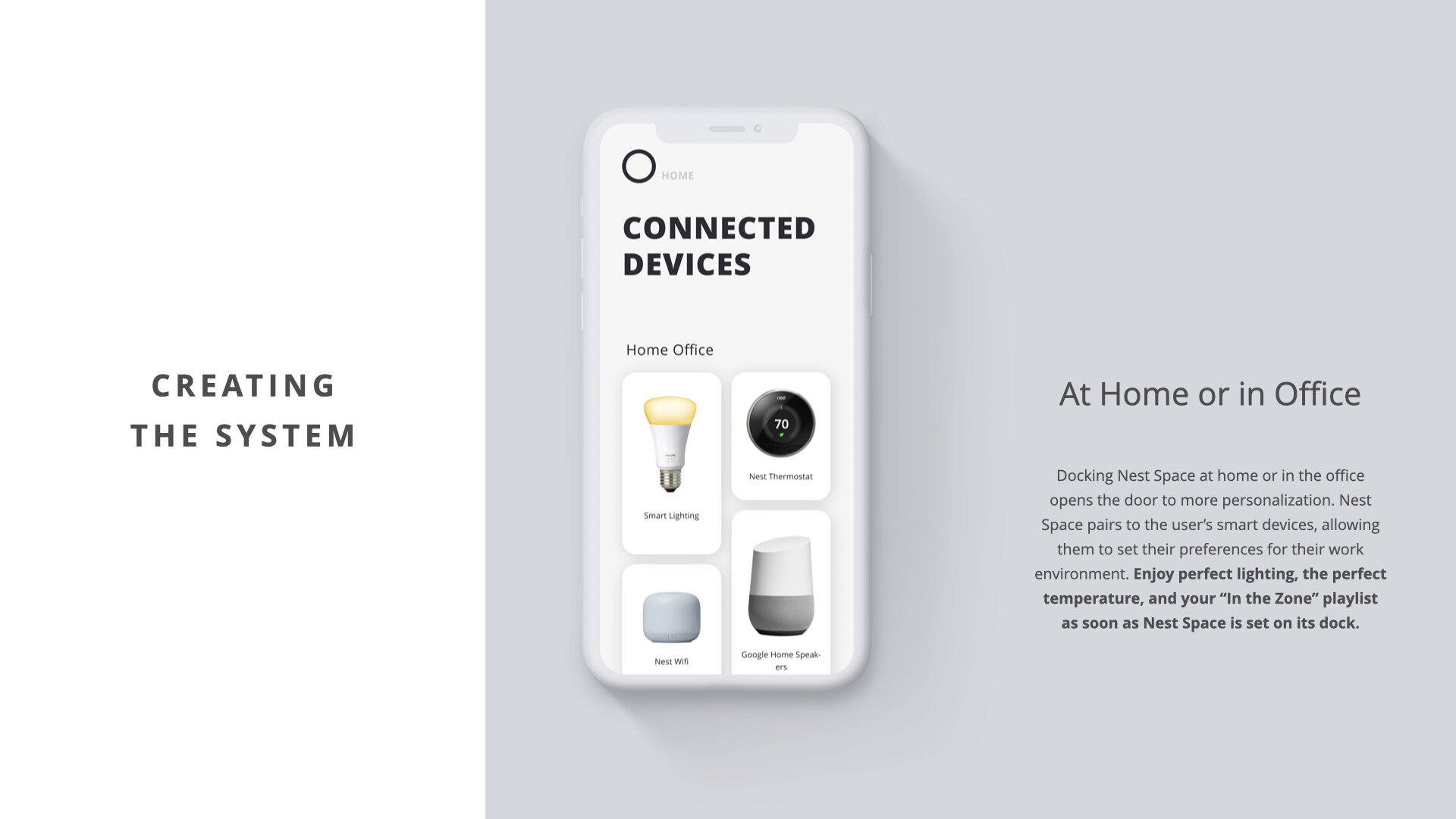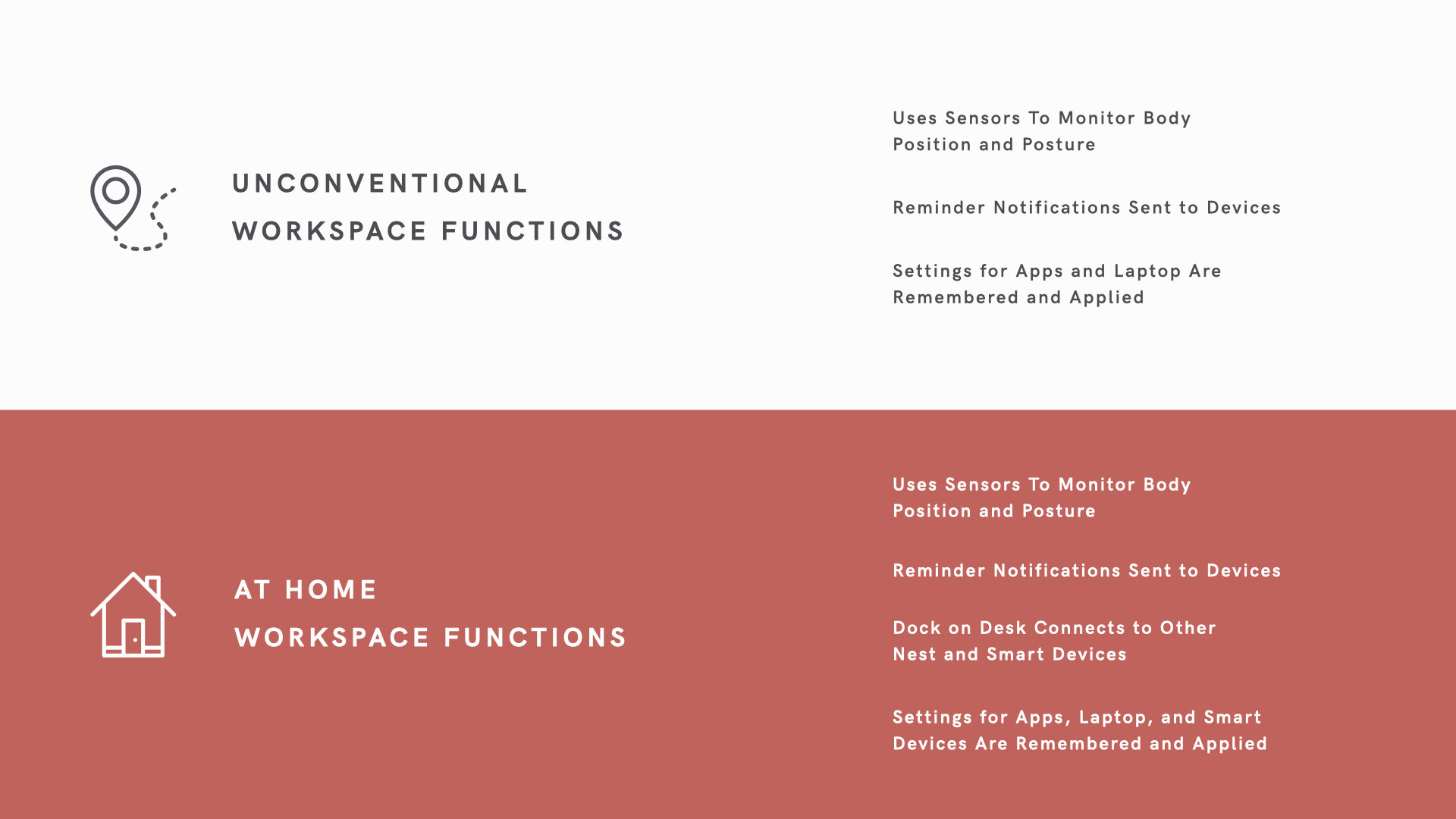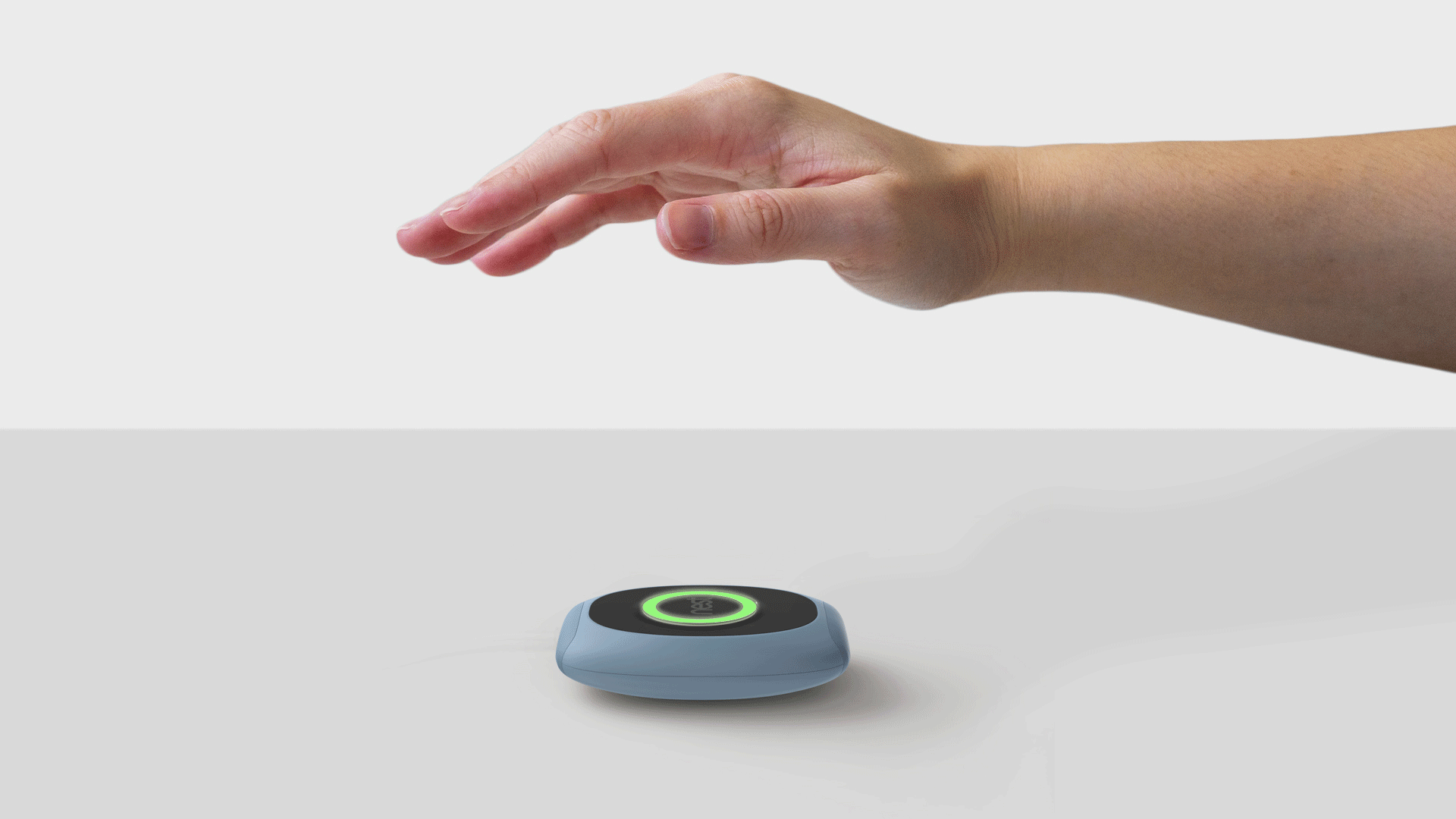Nest Space assistant
Cultivating Productivity in Any Environment - Spring 2020
“4 OF EVERY 10 MILLENIALS INTEND TO LEAVE THEIR FULL TIME EMPLOYERS TO WORK AS A FREELANCER IN 5 YEARS.”
CULTIVATING PRODUCTIVITY
The workforce is shifting away from full time work, instead opting for more contractual and freelance work. Current events have also created a new need for efficiency and productivity in out-of-office scenarios.
PROJECT BRIEFING
The PROBLEM
As careers and workplaces become less traditional, professionals are seeking ways to be equally as productive in unconventional workspaces as they are in office settings.
The GOAL
A device that aids the user in turning any environment into a workspace that evokes productivity, efficiency and wellbeing.
The OBJECTIVES
Harnessing the same level of productivity and efficiency no matter the location, learning and adapting to the user’s preferences, and decreasing the amount of time it takes to “get in the zone.”
Design intent
Companies like Steelcase and WELL publish articles and manuals outlining the dimensions of worker wellbeing and how to achieve them through the interior design of a space (such as an office building). I developed a design intent for this project by evaluating how these types of approaches can be translated into a product.
Workplace research
unconventional spaces
If people do not have their own personalized space and every day is a new work experience, it might be hard for some workers to get into a groove.
With customized controls and personalized reminders, the device could help reduce the amount of time it takes for the user to get into the zone to have a productive work session.
Ergonomics
Many people experience pain and strain due to neglecting taking breaks or switching up working posture.
While a user could try to monitor factors like their posture and eyestrain while working, the device could passively remind them, making it easy to implement healthy practices.
workplace sensors
Office sensors are an integral part of the IOT of an office because they collect data and communicate with other platforms to analyze and provide insight on office usage.
Using the same technology, the device could sense when the user has sat idle for too long and send them reminders when to move in order to promote healthy work habits.
Branding
The Nest brand implements traits in products that I hope to adopt. Nest is a line of smart home products that learn the user’s habits and adjust to their routine. Nest products have companion apps that allow them to be controlled remotely and provide feedback/use history analysis to the user.
Some traits of the Nest products that I wanted to adopt in my product were: learning and analyzing the user’s habits, ease of use and control, an app that show’s use history, and sending personalized alerts
brand Mantras
“WHAT IF IT HELPED YOU REMEMBER STUFF”
“WHAT IF THE MEASURE OF IT WORKING WAS THAT YOU NEVER HAD TO THINK ABOUT IT”
“WHAT IF IT COULD QUIETLY TAKE CARE OF THINGS”
“WHAT IF IT WAS SO EASY TO USE, YOU ACTUALLY USED IT”
Nest brand mantras that became goals for my project focused mainly on having passive reminders from a device that could learn and take care of things for you. Instead of having to actively remember to practice wellbeing during a work session, the product would remind you in an unobtrusive way.
Ideation
Ideation started with finding the right shape and proportions for my product and exploration of the relationship between the “puck” and the dock, as well as the relationship of the product as a whole with its environment.
Why not an app?
“With rising costs and the increased burden of chronic diseases such as diabetes, cardiovascular disease and cancer, people are turning more to life-style oriented and preventative approaches to health.”
Consumers are seeking everyday products and tech that promote wellbeing now more than ever. On top of the reasons above, the current market has opportunity for these types of products to be utilized in the workplace.
mock-ups
I made multiple cardboard mockups of different shapes and sizes to find the right general form and proportion for my product. Keeping desk real estate in mind, I wanted it to be small enough to slip into a bag, but not too small that it would easily be lost.
form development
Finding a form that fit the Nest brand, but felt professional was the goal for my form development. There were many directions I could’ve gone for how the “puck” was oriented in the dock but I decided on a horizontal orientation in which the puck was a ‘positive’ of the dock.
Using Fusion 360 and Solidworks, I explored how to best create the soft and round effect that the Nest products embody, without letting the form get too ‘cute’.
After deciding on a general form, small details were tweaked to find the right balance of a smooth “puffy” looking form that was still perceived as sleek. It was important that form informed intuitive function and orientation.
After finalizing the first read of the form, I went back to analyze the Nest branding language. All of their products that had sensors or cameras alluded to their function with a big glossy black face. I did more proportion studies to find the right balance to fit into the nest product line.
Through my exploration I found that the final iteration captures the effect of the large black face while also keeping the softness of the form. I also decided to make the device ambidextrous (with sensors on both the top and bottom) to align with Nest’s values of simplicity and ease of use.
Nest Space
Nest Space is a portable device that becomes part of the user’s everyday carry and docks in consistent work areas (such as a traditional office or home office) and can also work solo in an unconventional space to create the optimal environment for wellbeing and productivity during a work session.
Features offered by Nest Space:
Senses your seating position, sends passive reminders to encourage wellbeing (fixing posture, reducing eye strain ect.), curates customized preferences for the best work environment (automatically adjusting lighting, temperature, and music), provides user feedback and analytics, helps users create a work schedule based on habits to boost productivity
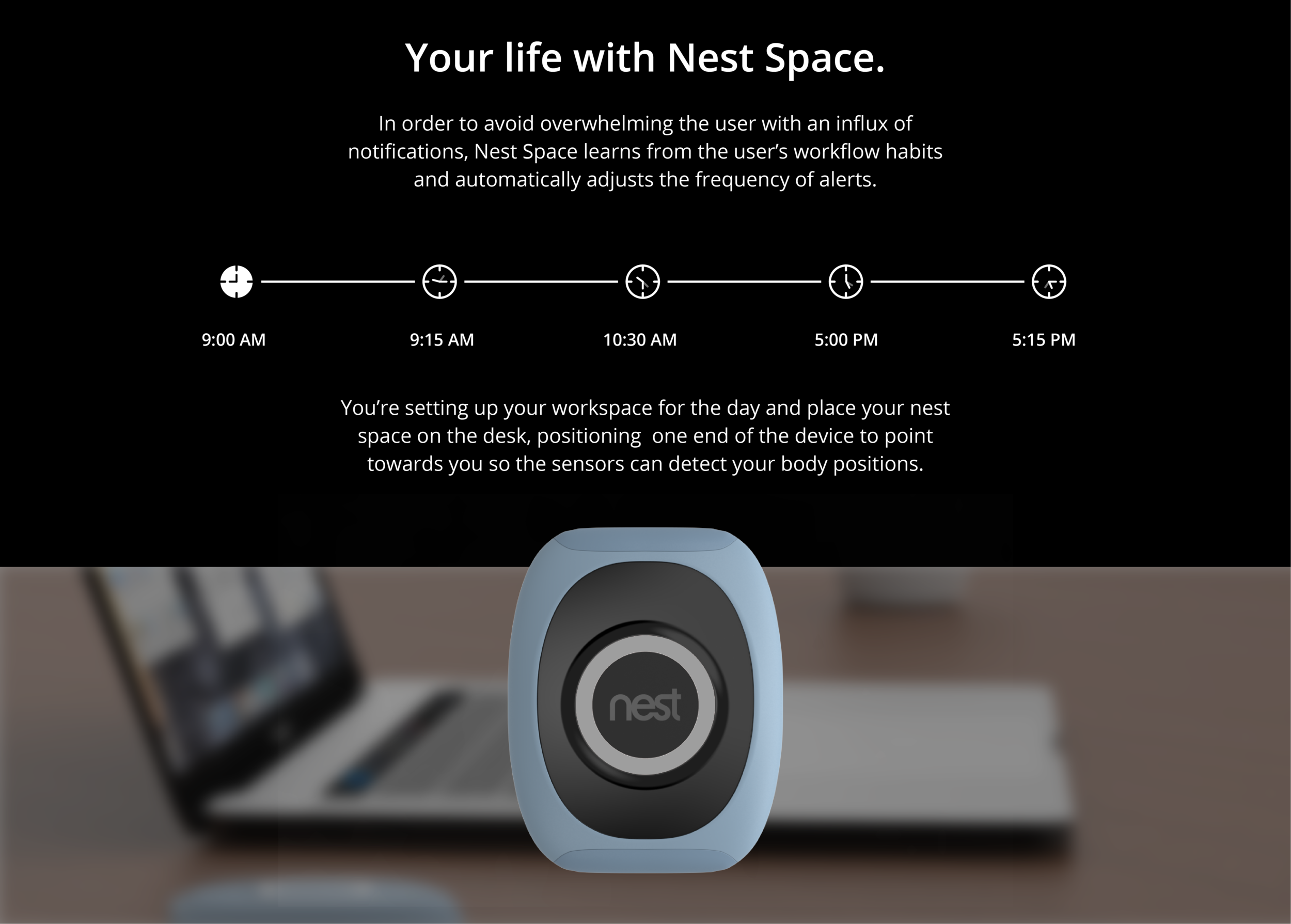
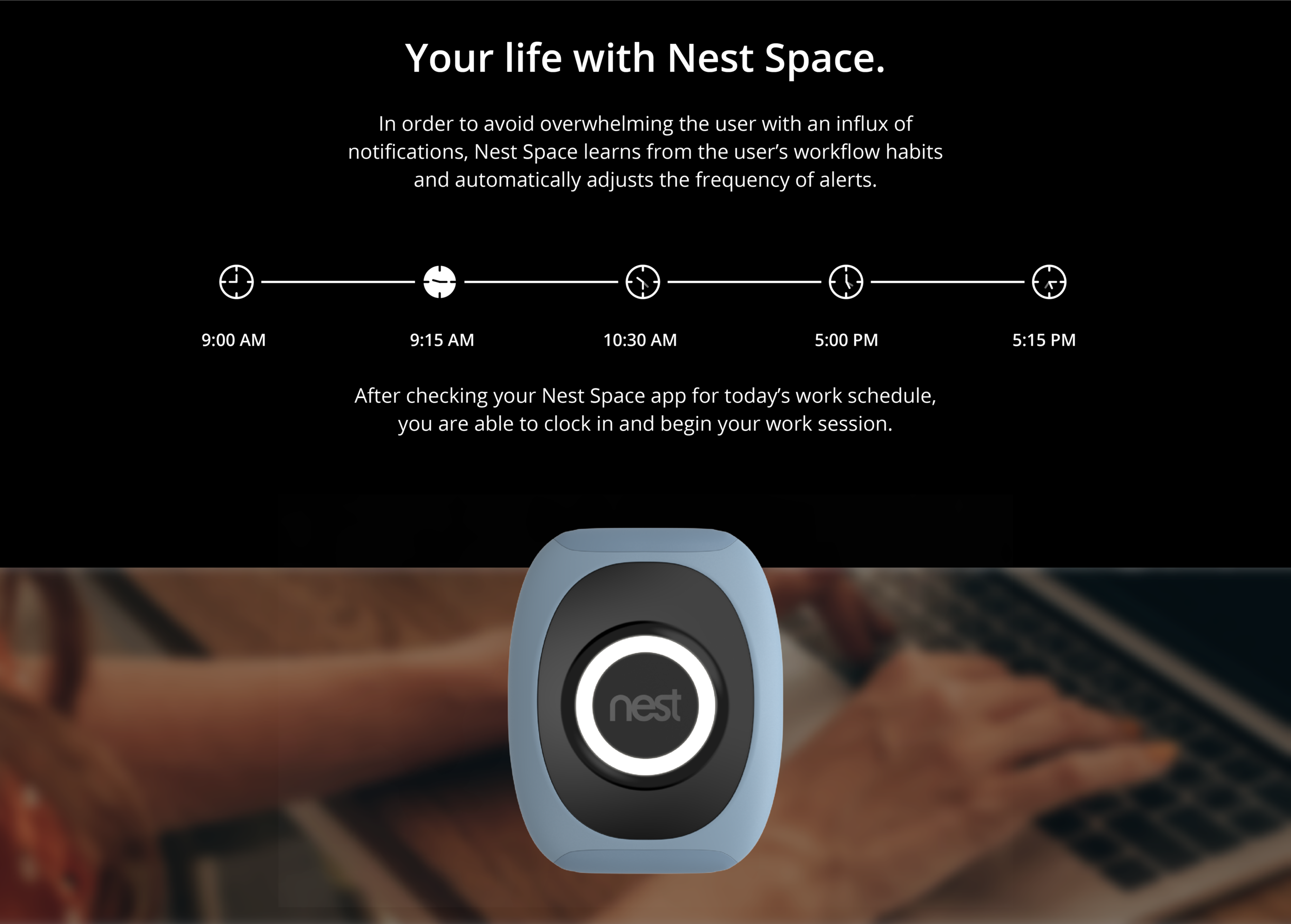
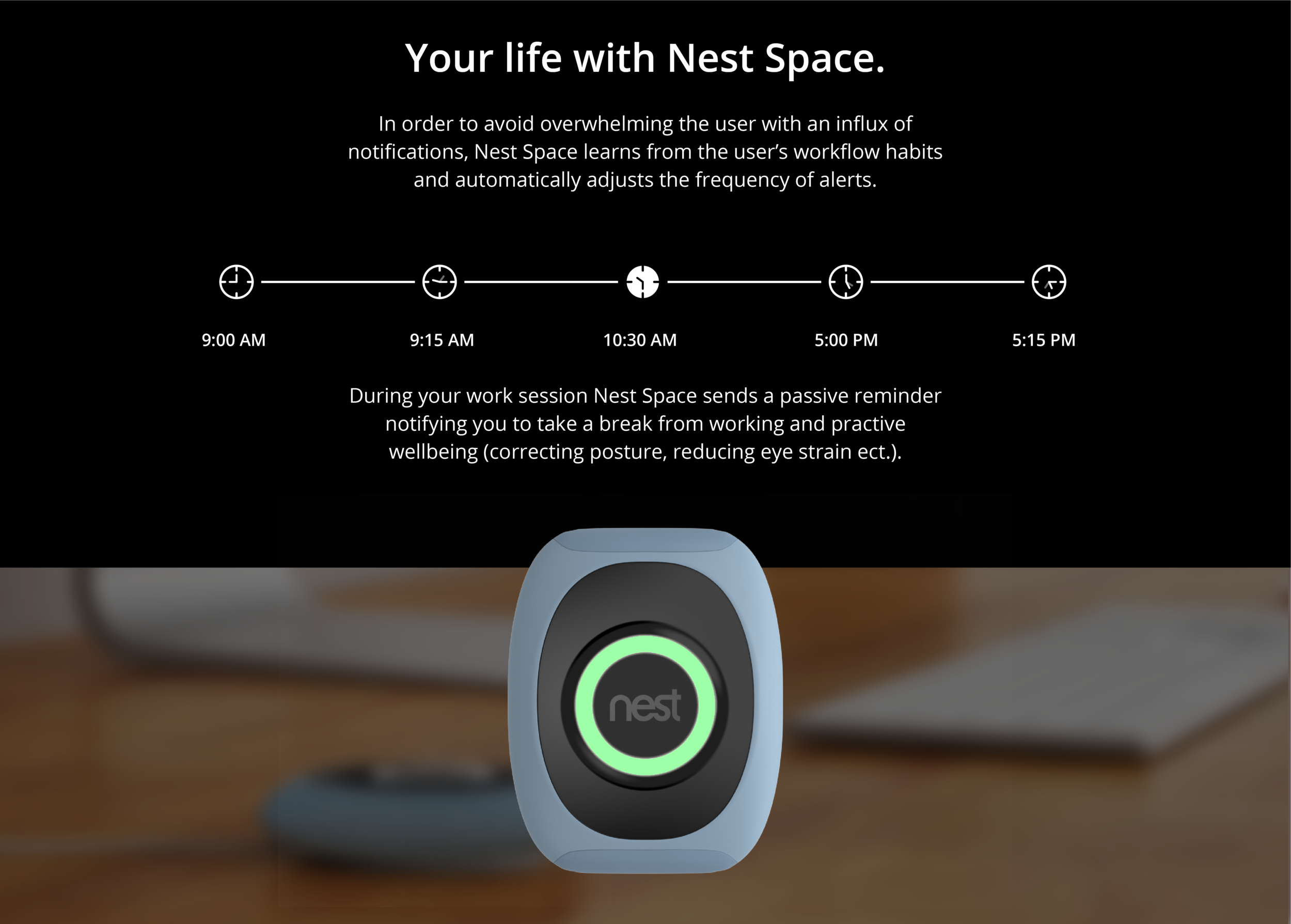
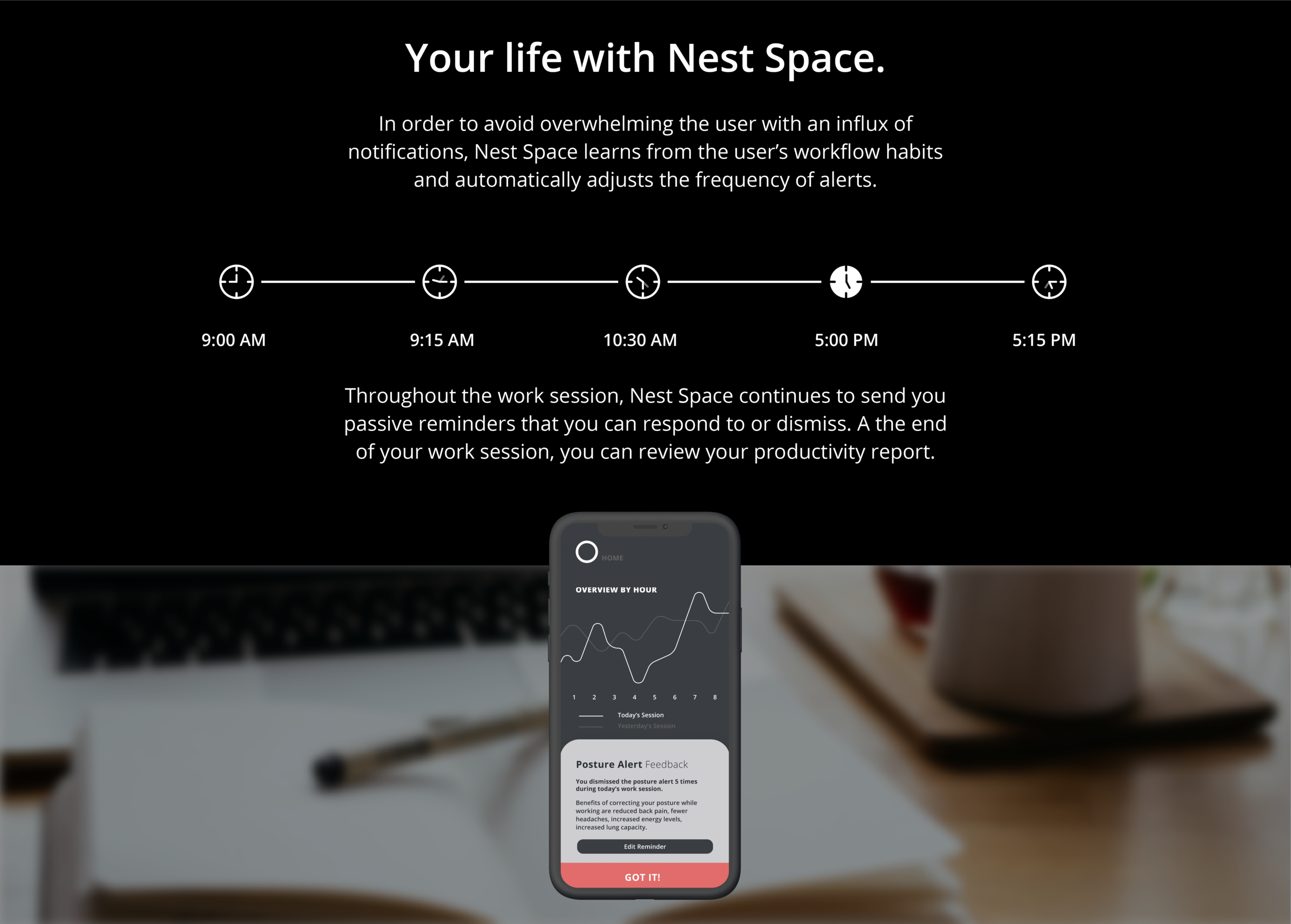
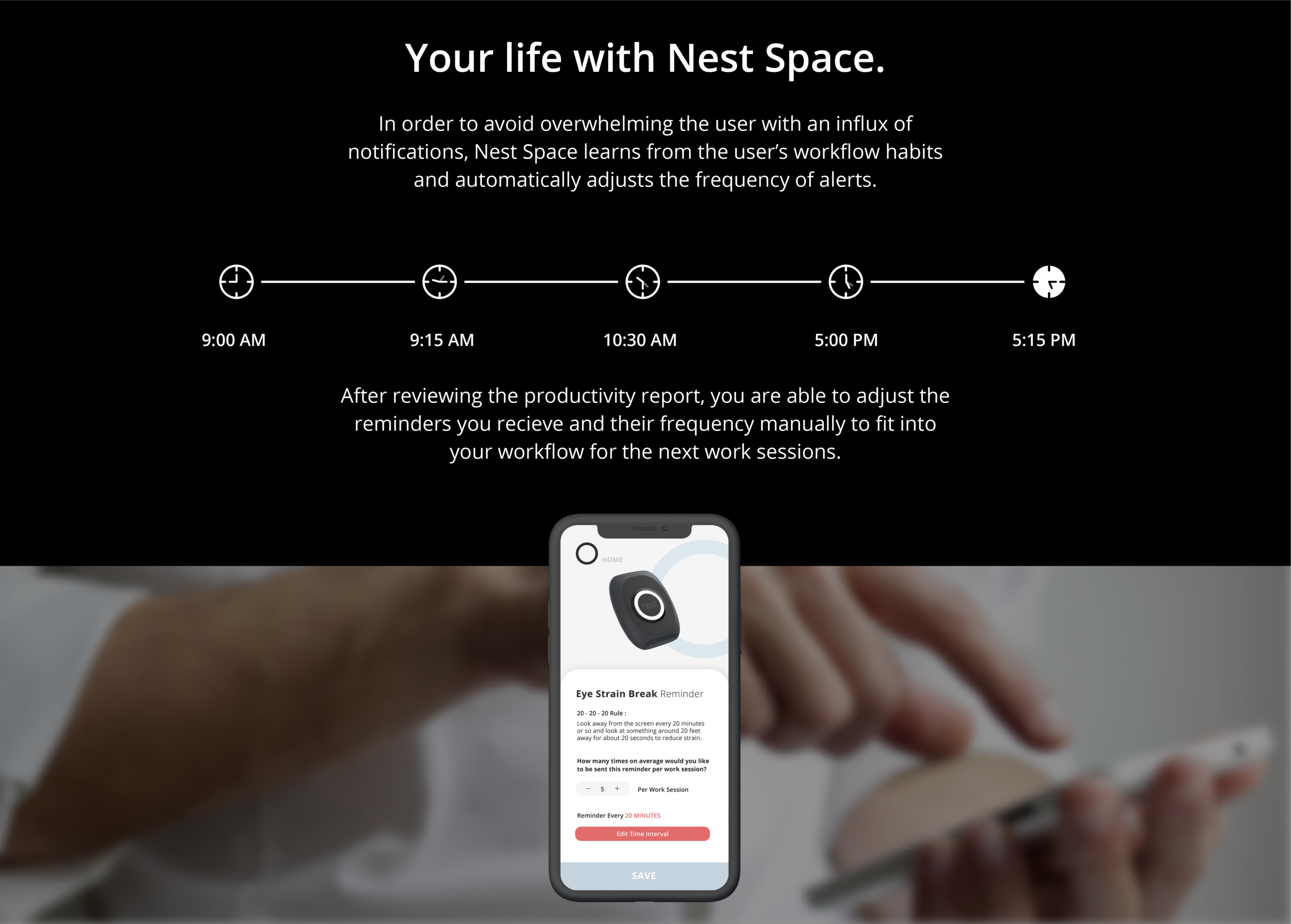
Through research, it became obvious that there was not a singular problem regarding workplace productivity, but many small problems and inconveniences. Instead of trying to focus on one big issue, I wanted the product to take the approach of creating “aha moments” that make the user’s workflow more convenient and efficient, much like added features in new cars (ex: backup cameras; HUD)
docked at home
Although Nest Space can be used solo, when used with the dock the user unlocks even more features. At home, Nest Space connects to the user’s smart devices allowing control of the entire workday experience.
out of the office
When out and about, Nest Space lies flat on a surface with the built-in sensors facing the user. Nest Space tracks habits like posture and sends reminders promoting the wellbeing of the user.
part of your edc
Nest Space measures about 3.25” x 2.5”. Small enough to throw in your bag, but not too small that it’s easily lost.
User Scenario
UX
gestural commands
Nest Space is equipped with sensors throughout the device’s body. The sensors that are housed under the black face on the top of the device enable the user to utilize gestural commands to dismiss notifications or perform other tasks that can be set up in their preferences.
The Nest Space companion app allows the user to customize their settings to control the entire experience of a work session. From scheduling wellbeing reminders to dimming the lights, the user has the power to set up their ideal workspace
